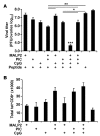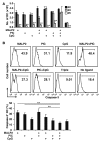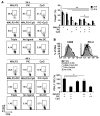Using 3 TLR ligands as a combination adjuvant induces qualitative changes in T cell responses needed for antiviral protection in mice
- PMID: 20101095
- PMCID: PMC2811160
- DOI: 10.1172/JCI39293
Using 3 TLR ligands as a combination adjuvant induces qualitative changes in T cell responses needed for antiviral protection in mice
Abstract
TLR ligands are promising candidates for the development of novel vaccine adjuvants that can elicit protective immunity against emerging infectious diseases. Adjuvants have been used most frequently to increase the quantity of an immune response. However, the quality of a T cell response can be more important than its quantity. Stimulating certain pairs of TLRs induces a synergistic response in terms of activating dendritic cells and eliciting/enhancing T cell responses through clonal expansion, which increases the number of responding T cells. Here, we have found that utilizing ligands for 3 TLRs (TLR2/6, TLR3, and TLR9) greatly increased the protective efficacy of vaccination with an HIV envelope peptide in mice when compared with using ligands for only any 2 of these TLRs; surprisingly, increased protection was induced without a marked increase in the number of peptide-specific T cells. Rather, the combination of these 3 TLR ligands augmented the quality of the T cell responses primarily by amplifying their functional avidity for the antigen, which was necessary for clearance of virus. The triple combination increased production of DC IL-15 along with its receptor, IL-15Ralpha, which contributed to high avidity, and decreased expression of programmed death-ligand 1 and induction of Tregs. Therefore, selective TLR ligand combinations can increase protective efficacy by increasing the quality rather than the quantity of T cell responses.
Figures






Similar articles
-
Modulation of γδ T cell responses by TLR ligands.Cell Mol Life Sci. 2011 Jul;68(14):2357-70. doi: 10.1007/s00018-011-0699-1. Epub 2011 May 11. Cell Mol Life Sci. 2011. PMID: 21560072 Free PMC article. Review.
-
Combination of poly I:C and Pam3CSK4 enhances activation of B cells in vitro and boosts antibody responses to protein vaccines in vivo.PLoS One. 2017 Jun 29;12(6):e0180073. doi: 10.1371/journal.pone.0180073. eCollection 2017. PLoS One. 2017. PMID: 28662082 Free PMC article.
-
Enhancement of the priming efficacy of DNA vaccines encoding dendritic cell-targeted antigens by synergistic toll-like receptor ligands.BMC Immunol. 2009 Aug 3;10:43. doi: 10.1186/1471-2172-10-43. BMC Immunol. 2009. PMID: 19650904 Free PMC article.
-
Adjuvanting a Simian Immunodeficiency Virus Vaccine with Toll-Like Receptor Ligands Encapsulated in Nanoparticles Induces Persistent Antibody Responses and Enhanced Protection in TRIM5α Restrictive Macaques.J Virol. 2017 Jan 31;91(4):e01844-16. doi: 10.1128/JVI.01844-16. Print 2017 Feb 15. J Virol. 2017. PMID: 27928002 Free PMC article.
-
Contribution of Toll-like receptors to the control of hepatitis B virus infection by initiating antiviral innate responses and promoting specific adaptive immune responses.Cell Mol Immunol. 2015 May;12(3):273-82. doi: 10.1038/cmi.2014.112. Epub 2014 Nov 24. Cell Mol Immunol. 2015. PMID: 25418467 Free PMC article. Review.
Cited by
-
Targeted Programming of the Lymph Node Environment Causes Evolution of Local and Systemic Immunity.Cell Mol Bioeng. 2016;9:418-432. doi: 10.1007/s12195-016-0455-6. Epub 2016 Jun 27. Cell Mol Bioeng. 2016. PMID: 27547269 Free PMC article.
-
Immunostimulatory effects of Toll-like receptor ligands as adjuvants in establishing a novel mouse model for pemphigus vulgaris.Clin Transl Med. 2024 Jul;14(7):e1765. doi: 10.1002/ctm2.1765. Clin Transl Med. 2024. PMID: 39031979 Free PMC article.
-
Improving the clinical impact of biomaterials in cancer immunotherapy.Oncotarget. 2016 Mar 29;7(13):15421-43. doi: 10.18632/oncotarget.7304. Oncotarget. 2016. PMID: 26871948 Free PMC article. Review.
-
A cell-based microarray to investigate combinatorial effects of microparticle-encapsulated adjuvants on dendritic cell activation.J Mater Chem B. 2016 Mar 7;4(9):1672-1685. doi: 10.1039/C5TB01754H. Epub 2015 Sep 30. J Mater Chem B. 2016. PMID: 26985393 Free PMC article.
-
Innate and adaptive immune correlates of vaccine and adjuvant-induced control of mucosal transmission of SIV in macaques.Proc Natl Acad Sci U S A. 2010 May 25;107(21):9843-8. doi: 10.1073/pnas.0911932107. Epub 2010 May 10. Proc Natl Acad Sci U S A. 2010. PMID: 20457926 Free PMC article.
References
-
- Granucci F, Ricciardi-Castagnoli P. Interactions of bacterial pathogens with dendritic cells during invasion of mucosal surfaces. Curr Opin Microbiol. 2003;6(1):72–76. - PubMed
Publication types
MeSH terms
Substances
Grants and funding
LinkOut - more resources
Full Text Sources
Other Literature Sources
Research Materials

